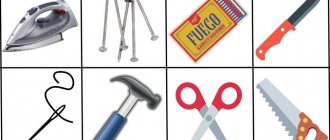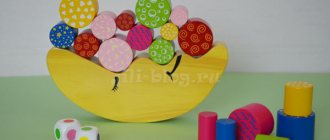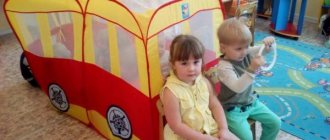Victoria Lysova
Card index of didactic games based on applications for preschool children
Junior group
"Merry little engine"
Goal: To develop the ability to pre-lay out (according to a certain sequence)
finished parts on a sheet of paper.
Material: Applique locomotive and parts .
Progress of the game: Consider the illustration of the locomotive in advance. Pay attention to the details of the locomotive (wheels, door, pipe, windows)
.
the application in front of the child , the teacher asks: What part is the train missing? Let's “fix”
the train and
“attach”
wheels to it.
"Colored Cups and Saucers"
Goal: Learn to select objects by color.
Material: Ready-made parts for cups and saucers (according to the number of children )
.
Progress of the game: Children are asked to choose a cup and saucer of the corresponding color and name the color. Or the child chooses a saucer and a cup to go with it.
"Funny Beads"
Purpose: To learn to use glue carefully: spread a thin layer of it with a brush on the back side of the figure to be glued (on a specially prepared oilcloth)
; apply the side coated with glue to a sheet of paper and press tightly with a napkin.
Material: Circles cut out of colored paper in different colors; finished craft.
Progress of the game: We provide the child with a finished craft and ask him to assemble the circles in the same sequence. And glue the beads.
“Show me the same ball”
Goal: To introduce children to the art of applique , to develop interest in this type of activity.
Material: Multi-colored balls.
Progress of the game: The teacher puts balls on the table and mixes them, selects one ball and asks the child to find the same one. For example, “I take a green ball, and you show me the same ball.”
.
"Color Path"
Goal: To consolidate knowledge of the shape of objects and their colors.
Material: Large multi-colored circles cut out of colored paper, as well as small squares. Lays out a multi-colored path. The distance between circles is 50 cm.
Progress of the game: The teacher shows and gives the child a card , for example, green, the child finds a green circle and places a card of the same color .
Middle group
“Collect animals from geometric shapes”
objects depicted in (birds, animals, flowers, insects, houses, both real and imaginary) from ready-made forms.
Material: Geometric shapes, animal cards .
Progress of the game: Children are asked to choose a card of any animal and use geometric shapes to assemble the animal.
"Magical Animals"
Goal: To foster interest in the application .
Material: Animal cards , geometric shapes (small shapes)
.
Progress of the game: Children are invited to choose a picture of any animal and decorate it with geometric shapes.
"Funny nesting dolls"
Goal: Continue to develop children's in visual arts.
Material: Pictures of nesting dolls , colored strips long and short and glue.
How to play: Children are asked to choose card and decorate it with long and short stripes.
“Make objects from strips”
Goal: To develop the ability to create images of different objects from stripes (fence, bench, ladder, tree, bush, etc.)
Material: Strips of different lengths, item templates.
Progress of the game: Children are invited to choose any template and lay out an outline from the stripes.
"Decorate the Christmas tree"
Goal: To teach to be friendly when evaluating the work of other children .
Material: Cone made of colored paper, geometric shapes of different sizes.
Progress of the game: Children are asked to choose a cone (Christmas tree)
and decorate it with different geometric shapes.
Senior group
"Let's decorate the mittens"
Goal: To develop aesthetic perception, teach to contemplate the beauty of the world around us.
Material: Ready-made mittens, geometric shapes, strips of different lengths.
Progress of the game: The teacher invites the children to take and decorate the mittens with geometric shapes and stripes.
"Collect transport"
Goal: To teach to convey in an image not only the basic properties of objects (shape, size, color)
.
Material: Ready-made geometric shapes of different sizes.
Progress of the game: Children are asked to choose geometric shapes and assemble vehicles.
"Make a Clown"
Goal: Improve visual skills and abilities.
Material: Geometric shapes of different sizes.
Progress of the game: Children are invited to choose geometric shapes and make a cheerful clown.
"Fairytale vases"
Goal: To encourage the creation of subject and subject compositions, supplementing them with details that enrich the images.
Material: Ready-made vases, circles.
MAGAZINE Preschooler.RF
Game techniques in the system of teaching applications to children of senior preschool age with general speech underdevelopmentOne of the main problems of education is the comprehensive and harmonious development of a person, his abilities and talents. In this complex process, the artistic development of preschool children represents the first stage, and it occurs by introducing the child to art, various types of artistic activities, among which applique occupies an important place, being a type of decorative and applied art.
Among the tasks facing a preschool institution, an important place is occupied by the task of preparing children for school. One of the main indicators of a child’s readiness for successful learning is correct, well-developed speech. The timely development of speech rebuilds the child’s entire psyche, allowing him to consciously perceive the phenomena of the surrounding world.
However, the success of children's aesthetic development and speech development largely depends on the nature of the pedagogical guidance of this type of activity. Of great importance is the use of optimal teaching methods and techniques that correspond to the specifics of visual activity and the age characteristics of children.
A necessary way to improve the methodology for guiding children's visual activities is to use gaming techniques that are specific to teaching preschool children. We believe that in relation to guiding the visual activities of children with general speech underdevelopment, the need to use gaming techniques has a special basis, which lies in the interrelationships of play, artistic creativity and speech development.
In a number of psychological studies conducted under the leadership of A.N. Leontyev and A.V. Zaporozhets, it was discovered that such mental processes as sensation (G. V. Endovitskaya), perception (Z. M. Boguslavskaya), memory (L. I. Zinchenko), attention (Z. M. Istomina), imagination (G. D. Lukov
O.M. Dyachenko, N.N. Palagin), thinking processes (A.V. Zaporozhets, Ya.Z. Neverovich), proceed most successfully in the game.
All researchers explain the educational effect of the game by the pronounced interest of children in the game. The closeness of play and artistic activity, as varieties of creativity, is manifested in the commonality of the leading mental processes that underlie them (imagination, feelings). It is known that these processes most easily arise and develop in game conditions. This provides grounds for using playful moments in guiding children's visual activities in order to activate imagination and feelings.
The fact that children easily learn “playfully” was noticed and proven by the great teacher K.D. Ushinsky, E.I. Tikheyeva, E.N. Vodovozova. Much credit for the development of game-based teaching methods belongs to E.A. Florina, N.P. Sakulina, R.I. Zhukovskaya, Z.M. Boguslavskaya, T.S. Komarova, etc.
G.G. paid great attention to the use of gaming techniques in visual arts classes. Grigorieva. In her opinion: “Game techniques in optimal combination with other teaching methods and techniques have a beneficial effect on the development of the individual, her creative potential, and artistic abilities...” .
To develop children’s speech in visual arts classes, various techniques are used: showing an object, showing depiction techniques, verbal explanation, examining an object, analyzing work, commenting on actions, using an adult’s speech as a model, etc. The artistic word is widely used in visual arts classes. It arouses interest in the topic, the content of the image, and helps to draw attention to children's works. The unobtrusive use of artistic words during the lesson creates an emotional mood and enlivens the image. It should be noted that the simultaneous use of several techniques in a lesson is very effective, for example, a combination of verbal explanation with demonstration of image techniques or with children reproducing their images (moving a brush without glue - on paper).
For correctional purposes, the work should be performed in small parts. The task is divided into two or three parts. This division ensures that the explanation alternates with the children doing the work. Switching types of activities increases children's performance, delays fatigue, helps them get involved in activities on time, and normalize its pace. And the correctness of the children’s work depends on this.
The specifics of the structure of the lesson are determined by the psychological characteristics of children with general speech underdevelopment - their rapid fatigue and distractibility. If a task must be completed in one sitting, children may miss some links in the work. Therefore, the task for visual activity is not explained in its entirety, but in parts, in several steps. This is especially useful for developing attention to speech and regulation of actions. Children must learn to understand from the explanation what can be done and what cannot be done yet. And not only understand, but also fulfill these requirements: restrain desires, wait patiently, start and finish at the same time, etc.
Both in mass kindergartens and in groups for children with speech impairments during visual arts classes, there is a close interweaving of children’s play and speech into it. Children “complete” with words what they cannot depict. These facts were noted in the studies of N.P. Sakulina, V.S. Mukhina, E.A. Flerina.
Teaching children through play is the basis of the proposals proposed by E.A. Flerina play exercises leading to consolidation of hand movements available to children: vertical, horizontal, circular. They give the drawn (pasted) object movement (the car is moving), based on the drawing (appliqué) they create a whole plot with the help of speech, animate and verbalize the objects, conveying their dialogue with onomatopoeia and accessible words. In her work “Aesthetic Education of a Preschooler” E.A. Flerina writes: “... the child feels the immediate quality of his speech, sometimes he looks for a “better” word , notices that it “came out well” , having found a rhyme for the line, he feels his luck, and this is his makes me happy."
What are the specifics of game-based teaching methods? By a system of game teaching techniques, we understand a set of techniques characterized by common essential features (the presence of game actions, an imaginary situation and an orientation towards solving didactic problems), classified in a certain way and included in the modern methodology for guiding children's visual activities.
On the one hand, like any techniques, they should be aimed at solving didactic problems. On the other hand, by their nature they should be as similar as possible to a real game and possess its essential features. This is all the more important because, unlike “real” free play, the game is offered in class by the teacher. Therefore, one of the signs of a gaming technique should be a gaming task.
The game task in these techniques is a unique formulation, defining the goal of the upcoming game actions. For example, the teacher says to the children: “Let’s build a house for the bear” or: “Let’s invite Parsley to visit” ; “Think about how you can help the bunny cross the river .
In the process of using a gaming technique, the number of gaming tasks may increase. Thus, the development of the game concept occurs.
Sometimes the teacher limits himself only to setting up a game problem, and then the usual educational work takes place during the lesson. It turns out that the children were “promised” a game, but the game did not take place. This happened because such a gaming technique did not contain the most important thing - the gaming actions through which any game is played. Therefore, game actions are an indispensable, one of the most important features of game teaching methods. With their help, a game task that is interesting for children is solved. So, to help the bunny cross the river, children make boats, “put” bunnies in them, “float” along the river, and “climb out” to the shore. Boats with “crooked sails” “hares don’t want to get into them . Children “repair” such boats, etc.
In cases where children are captivated by the events taking place in class, when they have a certain amount of knowledge and impressions about a given phenomenon, they themselves can set new tasks, come up with game actions and ways to carry them out.
Thus, gaming techniques are ways of jointly (teacher and children) developing a plot-game concept by setting game tasks and performing appropriate game actions aimed at teaching and developing children.
The teacher must remember that the content of game tasks and game actions must correspond to the children’s knowledge of the environment and their interests. Otherwise, the children's interest in the lesson is of a superficial, momentary nature, determined by the novelty of the paraphernalia or the unusualness of the game situation itself.
When developing game techniques, it is important to think not only about the content and logic of game actions, but also about their correspondence to the logic and meaning of real life situations. Otherwise, these techniques are far-fetched and unnatural. The more varied the content of the game actions, the more interesting and effective the gaming technique will be. Therefore, educators, when inventing them, should focus on the content of relevant life situations and the behavioral characteristics of humans and animals. If toys (substitutes) representing inanimate objects are used in gaming techniques, you should know the features of their use in real situations.
Thus, each game technique must have a game task and game actions. Their content is invented by the teacher, but always taking into account the children’s knowledge of the environment and their interests. The content, quantity, variety, and logic of game tasks and actions depend on this. If this condition is not taken into account by the teacher, then the child actually does not accept the play situation offered by the adult, soon loses interest in it, and the play influence on children is ineffective.
It is very important that the teacher is able to create truly playful relationships, without diluting the essence of the game with excessive didacticism. It’s sad when the teacher hastily and dryly says: “Children, a bear has come to us (at the same time she brings it from behind the door). He will have guests. He wants us to prepare him a treat . This exhausts the gaming technique. As a result, not only the essence of the game is lost, but the moral meaning of the situation is distorted.
For children with general speech underdevelopment, it is most important to conduct joint-individual activities in a small group. Each child is a participant in the activity, performs his or her assigned part of the overall work individually, and at the final stage it becomes part of the overall composition. Coordination of the actions of the participants in the work is carried out at the beginning - at the planning stage and at the end, when it is necessary to summarize the result. In subgroup classes, in contrast to frontal ones, each child has more opportunities for verbal expressions.
Correct guidance of the visual activities of children with general speech underdevelopment can only be carried out as a result of studying and knowing age-related and individual characteristics. Along with conducting frontal classes, it is absolutely necessary to use individual forms of classes with those students who especially need it. When cultivating interest in applications, you should be especially attentive to each child, be able to help him, give the necessary instructions, support the desire to do a good job and objectively evaluate his efforts.
Classes in visual arts, including appliqué, provide great opportunities for an individual approach. During the lesson, the teacher can approach each child, look at his work, give advice, guide the development of his creative idea and help in mastering technical skills.
As a result of the above, the following conclusions can be drawn:
- Acting as a specific figurative means of understanding reality, the application contributes to the manifestation of mental and speech activity of children, the development of concepts and ideas about the world around them, and the development of creativity
- in the process of application, special correctional tasks for the development of children’s speech are solved, the vocabulary is enriched, spoken language is improved, the appearance of coherent speech is prepared, etc.
- gaming techniques in optimal combination with other teaching methods and techniques have a huge impact on the creative development of children, form aesthetic feelings and ideas, develop imaginative thinking and imagination
- the use of commentary speech has a great influence on the development of speech perception, contributes to a more clear expression of the need for communication, speech activity based on accumulated speech means, and also leads children to understand a certain sequence of actions through a story and can be considered as a preparatory stage in learning to tell stories
- Applique classes provide ample opportunities for studying the characteristics of children and implementing an individual approach to each child, which contributes to the development of not only their artistic abilities, but also attention, observation, perseverance and will. The formation of these qualities is an essential condition for preparing a child for school and for the full development of the individual.
| Next > |




